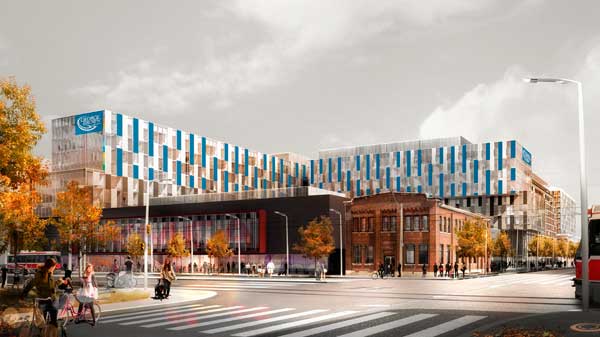
An artist’s rendering of the new George Brown College Residence that some are saying should be named after Lucie and Thornton Blackburn. Image courtesy of George Brown College.
The future at George Brown College (GBC) begins with the plan to have a fully functional student residence by 2016. The residence will be located at Front Street East and Cherry Street in the Pan Am Games Village. Once the building is successfully converted into student suites after the Pan Am Games, some students and community groups are campaigning the building be named after Lucie and Thornton Blackburn.
The Blackburn’s legacy begins in Kentucky where they were slaves in the 1800s. They escaped but slave hunters captured and and imprisoned them in Detroit in 1833. Fellow members of the African-American community broke Lucie out of jail by disguising her as a visitor and smuggling her out. As for Mr. Blackburn, a protest began outside of the prison allowing for Thornton to make his dramatic escape. Having successfully escaped slavery a second time, the couple made their way to Canada.
Upon arrival in Toronto in 1834, the Blackburns became prominent and successful throughout the community. Thornton worked as a waiter at Osgoode Hall when he had a vision of a taxi service. Once he obtained the blueprints from Montreal, the plan was in motion as they commissioned construction. The cabs, known as ‘The City” were red and yellow boxed cabs, colours that now represent the TTC, drawn by a single horse to carry up to four passengers. The City quickly became the first of many cab companies.
Mohammed Ali Aumeer, director of Education and Equity at the Student Association of GBC is an advocate for naming the residence after the Blackburns. Aumeer has in high hopes of the residency helping, “connect with the community from inside the college walls to outside the walls.”
George Brown’s desire to abolish slavery resulted in the North American Convention of Colored Freemen being held at St. Lawrence Hall in Sept. 1851. Thornton Blackburn was an associate of the anti-slavery leader and helped former slaves settle in Toronto.
Thornton and Lucie Blackburn are buried next to George Brown in Toronto’s Necropolis Cemetery
Aumeer gave insight to the background of the college and the role of Black History Month, “[George Brown] is about supporting and representing the community and the history of our neighbourhood. We don’t live in a bubble here at George Brown. We are interwoven in the downtown community.”
According to Jodi Salem, corporate communications manager at GBC, “City Councillor Pam Mcconnell has submitted a proposal to name our upcoming residence after the Blackburn family. The proposal will be considered, along with other options, but it will likely be some time before a final decision is made.”


